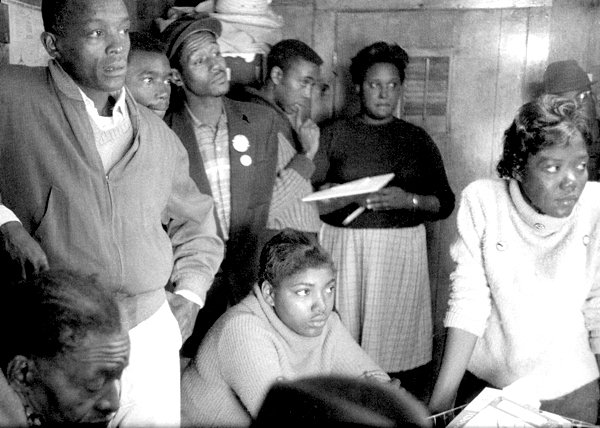Civil Rights Movement Tactics
Reading by Emilye Crosby
This text is provided as background information for A Documents-Based Lesson on the Voting Rights Act: A Case Study of SNCC’s work in Lowndes County and the Emergence of Black Power by Emilye Crosby.
SNCC workers prepare to go to Belzoni, Miss., in the Fall of 1963 to organize for the Freedom Vote. Ida Mae Holland is sitting in the center and the woman to the right in the white sweater is Mary Lane. They were both from Greenwood. Photo: Civil Rights Movement Archives.
The Civil Rights Movement utilized a range of tactics to address different problems. For example, nonviolent direct action was critical in challenging segregation in public accommodations. Direct action disrupted the status quo and made it difficult for those in power to ignore the issue of segregation. The best examples are the sit-ins and freedom rides. In some cases, the sit-ins led to immediate changes in local policy and widespread direct action protests eventually led to the passage of the Civil Rights Act of 1964 (which banned segregation in public accommodations). The freedom rides forced the Kennedy administration and the FCC to actually enforce two Supreme Court decisions (regarding interstate travel) that were being ignored by white southerners.
However, direct action was not particularly effective for addressing the denial of voting rights. To tackle this, SNCC organizers and their local allies used the much less visible approach of canvassing — going door-to-door meeting and talking to people. They built relationships, gave people a chance to practice voting applications, and provided transportation and support for those ready to try. They supplemented their canvassing with mass meetings and with Citizenship Education classes that helped people learn to pass the literacy tests (intended to prevent Blacks from voting) and political education workshops that introduced people to relevant laws and the duties of elected officials. These various educational efforts organized by the movement helped people increase their general understanding of citizenship and government and gave them an opportunity to develop their leadership skills. All of this work was slow, painstaking, and initially had few tangible successes. Until the passage of the Voting Rights Act, even when people tried to register, they were most often rejected and had little recourse.

